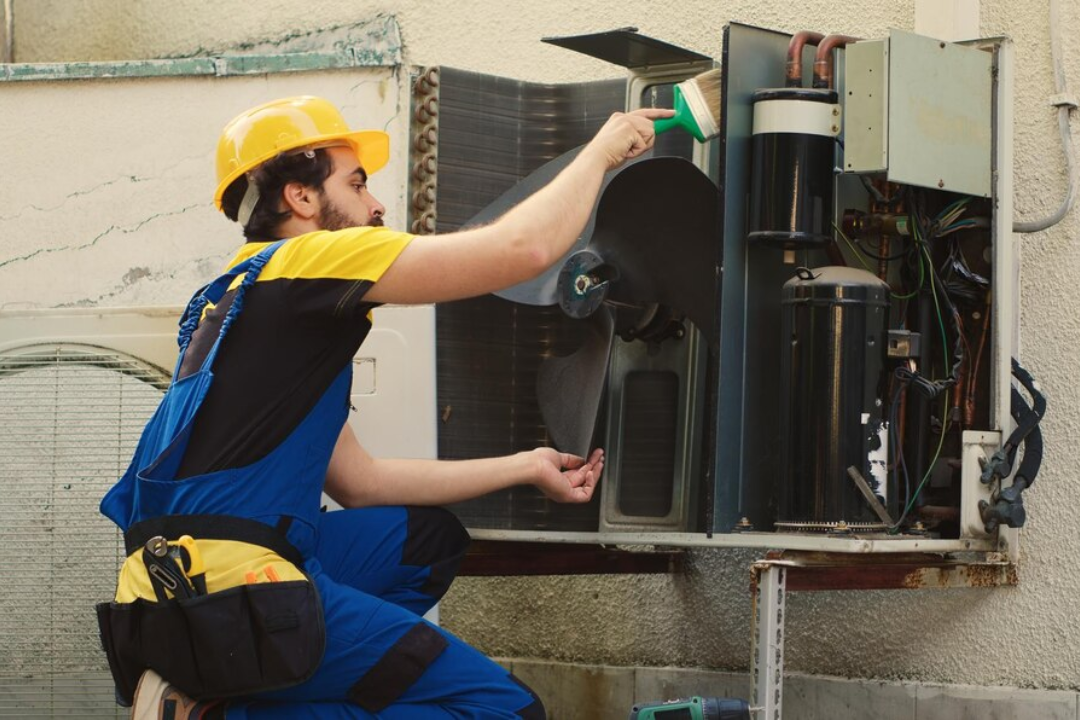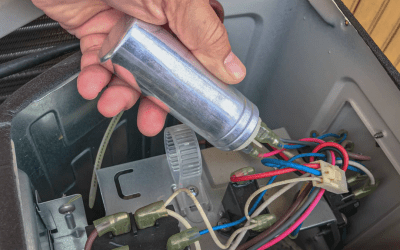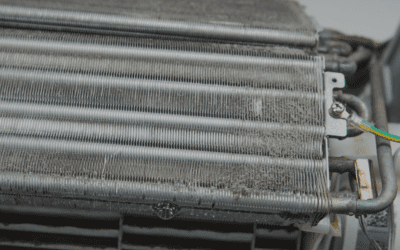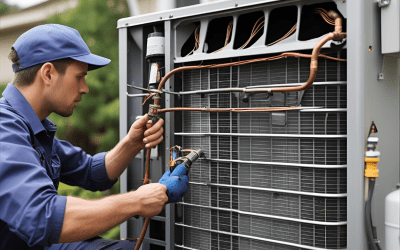In the past, AC repairs often came with significant challenges. Technicians struggled to find replacement components for older systems, leading to long wait times and high costs. Diagnosing issues was a tedious process, relying on manual inspections and trial-and-error methods, which sometimes resulted in missed problems or incorrect repairs. Additionally, older refrigerants like R-22 were harmful to the environment, making repairs not only costly but also unsustainable.
However, innovations like 3D printing for parts, AI-powered maintenance tools, and eco-friendly refrigerants like Hydrofluoro-olefins (HFOs) are improving AC repairs. Smart systems now allow for remote monitoring and faster diagnostics, making repairs quicker, easier, and more efficient. These advancements solve past problems and help create a more energy-efficient and sustainable future for AC systems.
Let us learn more about how these exciting advancements in AC repair components are changing how we repair and maintain air conditioners.
Understanding Advancements in AC Repair Components
Scroll Compressor Technology
One of the most innovative AC repair components in air conditioning systems is the scroll compressor. Unlike traditional piston compressors, which use reciprocating motion to compress refrigerant, scroll compressors rely on two interleaved spiral-shaped components: a fixed scroll and a moving scroll. As the moving scroll orbits the fixed scroll, it traps and compresses the refrigerant in pockets, gradually reducing its volume. This continuous, smooth motion eliminates the vibrations and wear associated with piston-based compressors, resulting in reduced friction and more energy-efficient, quieter operation.
Variable Frequency Drive Motors
Traditional motors run at a constant speed, which can be inefficient for applications where varying speeds are required. However, Variable Frequency Drive (VFD) allows motors to operate at the exact speed needed for a given task. It works by adjusting the frequency and voltage supplied to an electric motor, which in turn controls its rotational speed.
The VFD consists of three main components: a rectifier, a DC bus, and an inverter. The rectifier converts incoming alternating current (AC) to direct current (DC), which is then stored in the DC bus. The inverter then converts the DC power back to AC at the desired frequency and voltage. By varying the output frequency, the VFD can control the motor’s speed with high precision, making it ideal for applications such as pumps, fans, and HVAC systems, where demand fluctuates.
One of the primary benefits of VFD motors is their ability to reduce mechanical stress on motors and other components, extending the lifespan of equipment and minimizing maintenance needs.
Hydrofluoro-olefin (HFO) Refrigerants
Hydrofluoro-olefin (HFO) refrigerants are a newer generation of refrigerants developed to address the environmental concerns associated with traditional refrigerants like chlorofluorocarbons (CFCs) and hydrofluorocarbons (HFCs). HFOs are made by replacing some of the hydrogen atoms in HFCs with carbon-carbon double bonds (unsaturation), which gives them unique chemical properties. The most commonly used HFO refrigerants include HFO-1234yf, HFO-1234ze, and HFO-1336mzz, among others.
These refrigerants have a low Global Warming Potential (GWP), which is a key factor in their environmental advantages. The GWP of a refrigerant is a measure of how much heat it can trap in the atmosphere over a specified period (typically 100 years) relative to carbon dioxide (CO2). HFOs have a GWP that is close to zero, which means that they have a minimal impact on global warming when released into the atmosphere. In addition to their low GWP, HFOs do not contribute to ozone depletion, unlike chlorofluorocarbons (CFCs) and hydrochlorofluorocarbons (HCFCs), which were phased out due to their harmful effects on the ozone layer.
HFOs also offer good thermodynamic performance, making them suitable for a wide range of applications, including automotive air conditioning, commercial refrigeration, and heat pumps.
Plate-Fin Heat Exchanger
Another advancement in AC repair components is the plate-fin heat exchanger. Their design maximizes heat transfer efficiency by using thin, flat plates and fins, increasing the surface area. This allows the system to use less refrigerant while maintaining or improving cooling performance, reducing both environmental impact and operational costs. The compact design makes them space-efficient, and ideal for systems with limited space, such as residential or commercial HVAC units. Also, plate-fin heat exchangers are less prone to clogging compared to traditional tube-and-fin designs, offering greater reliability and requiring less maintenance.
Microchannel Heat Transfer Technology
Microchannel heat transfer technology is a highly efficient and advanced solution used in modern HVAC systems, refrigeration, and automotive applications. It utilizes heat exchangers made from flat tubes containing multiple tiny microchannels, typically less than 1 millimeter in diameter, which increases the surface area for heat transfer. These tubes are surrounded by aluminum fins and housed in an aluminum casing, making the system lightweight, durable, and resistant to corrosion.
Additionally, they are compatible with low-GWP (Global Warming Potential) refrigerants, helping meet environmental standards. Recent advancements, including anti-corrosion coatings and optimized designs for improved flow distribution, are improving AC performance sustainably, making microchannel technology a favored option for energy-efficient cooling and heating systems.
Aluminum Evaporator Coil Design
Aluminum evaporator coils are increasingly replacing copper coils in modern air conditioning systems. Aluminum offers superior corrosion resistance, especially in humid or coastal environments, where copper coils are prone to rust and deterioration. Aluminum’s excellent heat conductivity allows it to efficiently absorb heat from the air, improving the system’s overall performance. It is also lightweight and cost-effective compared to copper, making it a more economical choice for HVAC systems. The durability and corrosion resistance of aluminum coils ensure a longer lifespan, reducing the need for frequent repairs and replacements, which enhances the reliability of the system.
High-Efficiency Particulate Air (HEPA) Filters
Modern air conditioning components like high-efficiency particulate Air (HEPA) filters are designed to capture 99.97% of airborne particles as small as 0.3 microns. These filters are highly effective at trapping dust, pollen, mold, bacteria, and even some viruses, improving indoor air quality significantly. HEPA filters are especially beneficial in environments where clean air is critical, such as hospitals, laboratories, and homes with allergy sufferers. In addition to their health benefits, HEPA filters help maintain HVAC system efficiency by preventing dust and debris from accumulating within the system. This reduces the likelihood of clogging and ensures that the system operates at peak performance, providing cleaner air and energy savings.
Electronic Expansion Valve (EEV)
The Electronic Expansion Valve (EEV) is a precise control device that regulates the flow of refrigerant into the evaporator coil. It uses electronic sensors and controllers to adjust the refrigerant flow based on real-time conditions such as pressure and temperature. This level of precision ensures that the system operates at optimal efficiency, reducing refrigerant waste and improving overall performance. EEVs are more accurate and reliable than traditional thermostatic expansion valves (TXVs), which rely on mechanical components and are prone to wear over time. By providing better control, this energy-efficient air conditioner part helps maintain the correct refrigerant charge, ensuring consistent cooling.
Heat Recovery Ventilation (HRV)
Traditional ventilation systems rely on either natural airflow or mechanical fans to exchange indoor and outdoor air. While these systems can provide fresh air, they often result in significant energy losses because the incoming air requires additional heating or cooling to match indoor temperatures. In contrast, Heat Recovery Ventilation (HRV) systems are designed to recover heat from the outgoing stale air and use it to preheat or precool the incoming fresh air, which reduces the need for additional heating or cooling. They can recover up to 70-90% of the heat from the exhaust air.
HRVs are particularly beneficial in regions with extreme climates or modern, tightly sealed buildings where natural ventilation is limited. By removing indoor contaminants such as dust, allergens, and volatile organic compounds (VOCs), HRVs create a healthier living or working environment.
New components now give better performance, longer life, and less cost. Ask what’s new.
Revolutionizing AC Repairs: What to Expect in the Coming Years
Here’s a look at the key developments on the horizon:
- AI-Powered Diagnostics: Artificial intelligence will revolutionize the diagnostic process by analyzing data from sensors and historical records to detect issues quickly and accurately. It will predict potential failures before they occur, allowing technicians to address problems proactively, reduce downtime, and avoid costly repairs.
- Smart Thermostat Integration: As smart thermostats become more common, their integration with AC systems will allow technicians to monitor and diagnose issues remotely. By accessing real-time data from these devices, problems can be identified quickly, and adjustments can be made without needing to visit the site.
- 3D Printing for Replacement Components: 3D printing technology will enable repair persons to create custom replacement parts on-site, eliminating the need for lengthy waits for manufacturer shipments. This will reduce repair times, especially for rare or discontinued parts, and lower overall repair costs.
- Energy Recovery and Efficiency Systems: The focus on sustainability will drive the development of advanced energy recovery systems that capture and reuse waste energy from AC units. These eco-friendly AC repair solutions will help reduce energy consumption, lower operational costs, and make HVAC systems more environmentally friendly.
- Augmented Reality (AR) for Technician Assistance: Augmented reality will provide technicians with real-time access to detailed guides, schematics, and troubleshooting instructions while working on AC units. AR will also be used for technician training, providing interactive simulations and virtual troubleshooting scenarios. It will improve accuracy, reduce the likelihood of mistakes, and speed up repairs.
Conclusion
While older systems might feel familiar, they can lead to more headaches and expenses over time. The benefits of upgrading AC repair components go beyond just fixing problems. Newer components are designed to last longer, use less energy, and perform better. Plus, eco-friendly refrigerants reduce your environmental impact and comply with current regulations.
If you’re looking for AC repair in New Braunfels, Classic Air Conditioning and Heating is here to help. Contact us today for expert service and energy-saving solutions!






